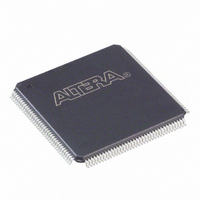EP1C3T144C6N Altera, EP1C3T144C6N Datasheet - Page 13

EP1C3T144C6N
Manufacturer Part Number
EP1C3T144C6N
Description
IC CYCLONE FPGA 2910 LE 144-TQFP
Manufacturer
Altera
Series
Cyclone®r
Datasheet
1.EP1C3T144C8.pdf
(106 pages)
Specifications of EP1C3T144C6N
Number Of Logic Elements/cells
2910
Number Of Labs/clbs
291
Total Ram Bits
59904
Number Of I /o
104
Voltage - Supply
1.425 V ~ 1.575 V
Mounting Type
Surface Mount
Operating Temperature
0°C ~ 85°C
Package / Case
144-TQFP, 144-VQFP
Family Name
Cyclone®
Number Of Logic Blocks/elements
2910
# I/os (max)
104
Frequency (max)
405.2MHz
Process Technology
0.13um (CMOS)
Operating Supply Voltage (typ)
1.5V
Logic Cells
2910
Ram Bits
59904
Operating Supply Voltage (min)
1.425V
Operating Supply Voltage (max)
1.575V
Operating Temp Range
0C to 85C
Operating Temperature Classification
Commercial
Mounting
Surface Mount
Pin Count
144
Package Type
TQFP
Lead Free Status / RoHS Status
Lead free / RoHS Compliant
Number Of Gates
-
Lead Free Status / Rohs Status
Compliant
Other names
544-1662
Available stocks
Company
Part Number
Manufacturer
Quantity
Price
Company:
Part Number:
EP1C3T144C6N
Manufacturer:
ALTERA
Quantity:
250
Part Number:
EP1C3T144C6N
Manufacturer:
ALTERA
Quantity:
20 000
Altera Corporation
May 2008
functions. Another special packing mode allows the register output to
feed back into the LUT of the same LE so that the register is packed with
its own fan-out LUT. This provides another mechanism for improved
fitting. The LE can also drive out registered and unregistered versions of
the LUT output.
LUT Chain and Register Chain
In addition to the three general routing outputs, the LEs within a LAB
have LUT chain and register chain outputs. LUT chain connections allow
LUTs within the same LAB to cascade together for wide input functions.
Register chain outputs allow registers within the same LAB to cascade
together. The register chain output allows a LAB to use LUTs for a single
combinatorial function and the registers to be used for an unrelated shift
register implementation. These resources speed up connections between
LABs while saving local interconnect resources.
Interconnect” on page 2–12
register chain connections.
addnsub Signal
The LE's dynamic adder/subtractor feature saves logic resources by
using one set of LEs to implement both an adder and a subtractor. This
feature is controlled by the LAB-wide control signal addnsub. The
addnsub signal sets the LAB to perform either A + B or A − B. The LUT
computes addition; subtraction is computed by adding the two's
complement of the intended subtractor. The LAB-wide signal converts to
two's complement by inverting the B bits within the LAB and setting
carry-in = 1 to add one to the least significant bit (LSB). The LSB of an
adder/subtractor must be placed in the first LE of the LAB, where the
LAB-wide addnsub signal automatically sets the carry-in to 1. The
Quartus II Compiler automatically places and uses the adder/subtractor
feature when using adder/subtractor parameterized functions.
LE Operating Modes
The Cyclone LE can operate in one of the following modes:
■
■
Each mode uses LE resources differently. In each mode, eight available
inputs to the LE⎯ the four data inputs from the LAB local interconnect,
carry-in0 and carry-in1 from the previous LE, the LAB carry-in
from the previous carry-chain LAB, and the register chain connection⎯ are
directed to different destinations to implement the desired logic function.
LAB-wide signals provide clock, asynchronous clear, asynchronous
Normal mode
Dynamic arithmetic mode
for more information on LUT chain and
“MultiTrack
Logic Elements
Preliminary
2–7















